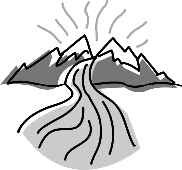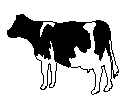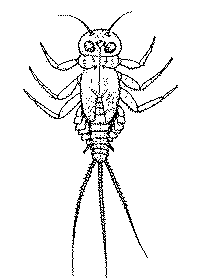
|
|
|
|
|

|
|
|
|
|
DISSOLVED OXYGEN (DO)
Dissolved Oxygen (DO) is found in microscopic bubbles of oxygen that are mixed in the water and occur between water molecules. DO is a very important indicator of a water body's ability to support aquatic life. Fish "breathe" by absorbing dissolved oxygen through their gills. Oxygen enters the water by absorption directly from the atmosphere or by aquatic plant and algae photosynthesis. Oxygen is removed from the water by respiration and decomposition of organic matter.
 Dissolved Oxygen can be measured with an electrode and meter or with
field test kits. The electronic meter does not measure oxygen directly;
rather, it uses electrodes to measure the partial pressure of oxygen in
the water, which is converted to oxygen mass weight concentration. The
field test kits (such as a drop bottle, a microburet, or a digital titrator)
involve adding a solution of known strength to a treated sample of water
from the stream. The amount of solution required to change the color of the
sample reflects the concentration of DO in the sample. The amount of oxygen
dissolved in water is expressed as a concentration, in milligrams per liter
(mg/l) of water.
Dissolved Oxygen can be measured with an electrode and meter or with
field test kits. The electronic meter does not measure oxygen directly;
rather, it uses electrodes to measure the partial pressure of oxygen in
the water, which is converted to oxygen mass weight concentration. The
field test kits (such as a drop bottle, a microburet, or a digital titrator)
involve adding a solution of known strength to a treated sample of water
from the stream. The amount of solution required to change the color of the
sample reflects the concentration of DO in the sample. The amount of oxygen
dissolved in water is expressed as a concentration, in milligrams per liter
(mg/l) of water.
Dissolved oxygen levels are also often reported in percent saturation. Temperature affects DO concentrations, and calculating the percent saturation will factor out the effect of temperature. The "saturation level" is the maximum concentration of dissolved oxygen that would be present in water at a specific temperature, in the absence of other factors. Scientists have determined the saturation DO level for various temperatures. Saturation levels also vary with elevation. Percent saturation is calculated by dividing the measured dissolved oxygen concentration by the saturation level and multiplying by 100.
This equation is shown as:
% Saturation = (DO / Saturation Level) x 100
Factors Affecting DO
Volume and velocity of water flowing in the water body
In fast-moving streams, rushing water is aerated by bubbles as it churns over rocks and falls down hundreds of tiny waterfalls. These streams, if unpolluted, are usually saturated with oxygen. In slow, stagnant waters, oxygen only enters the top layer of water, and deeper water is often low in DO concentration due to decomposition of organic matter by bacteria that live on or near the bottom of the reservoir.


Climate/Season
The colder the water, the more oxygen can be dissolved in the water. Therefore, DO concentrations at one location are usually higher in the winter than in the summer.
During dry seasons, water levels decrease and the flow rate of a river slows down. As the water moves slower, it mixes less with the air, and the DO concentration decreases. During rainy seasons, oxygen concentrations tend to be higher because the rain interacts with oxygen in the air as it falls.
More sunlight and warmer temperatures also bring increased activity levels in plant and animal life; depending on what organisms are present, this may increase or decrease the DO concentration.
 The type and number of
organisms
in the water body
The type and number of
organisms
in the water body
During photosynthesis, plants release oxygen into the water. During respiration, plants remove oxygen from the water. Bacteria and fungi use oxygen as they decompose dead organic matter in the stream. The type of organisms present (plant, bacteria, fungi) affect the DO concentration in a water body. If many plants are present, the water can be supersaturated with DO during the day, as photosynthesis occurs. Concentrations of oxygen can decrease significantly during the night, due to respiration. DO concentrations are usually highest in the late afternoon, because photosynthesis has been occurring all day. For an example of how DO can vary from day to night, select here .

Altitude
Oxygen is more easily dissolved into water at low altitudes than at high altitudes, because of higher atmospheric pressure.
Dissolved or suspended solids
Oxygen is more easily dissolved into water with low levels of dissolved or suspended solids. Waters with high amounts of salt, such as the ocean (which contains about 35 grams of salt for each 1000 grams of water) have low concentrations of DO. Freshwater lakes, streams, and tap water generally contain much less salt, so DO concentrations are higher. As the amount of salt in any body of water increases, the amount of dissolved oxygen decreases. An increase in salt concentration due to evaporation of water from an ecosystem tends to reduce the dissolved oxygen available to the ecosystemís inhabitants.
Runoff from roads and other paved surfaces can bring salts and sediments into stream water, increasing the dissolved and suspended solids in the water.
Amount of nutrients in the water
Nutrients are food for algae, and water with high amounts of nutrients can produce algae in large quantities. When these algae die, bacteria decompose them, and use up oxygen. This process is called eutrophication. DO concentrations can drop too low for fish to breathe, leading to fish kills. However, nutrients can also lead to increased plant growth. This can lead to high DO concentrations during the day as photosynthesis occurs, and low DO concentrations during the night when photosynthesis stops and plants and animals use the oxygen during respiration. For an example of how DO can vary from day to night, select here.
Nitrate and
phosphate
are nutrients. Nitrate is found in sewage discharge, fertilizer runoff, and
leakage from septic systems. Phosphate is found in fertilizer and some
detergents.

Organic Wastes
Organic wastes are the remains of any living or once-living organism. Organic wastes that can enter a body of water include leaves, grass clippings, dead plants or animals, animal droppings, and sewage. Organic waste is decomposed by bacteria; these bacteria remove dissolved oxygen from the water when they breathe. If more food (organic waste) is available for the bacteria, more bacteria will grow and use oxygen, and the DO concentration will drop.
Directly downstream from where sewage effluent is discharged to a river, DO content often decreases, because of the increase in growth rate of bacteria that consume the organic matter contained in the effluent. The degree and extent of the DO "sag" depends on the Biological Oxygen Demand (BOD) of the effluent (how much oxygen the effluent can consume) (Giller and Malmqvist, 1998).
Riparian Vegetation
 Shading tends to lower average summer temperature and reduce
the daily duration of higher temperature. Removing trees reduces shade on
the creek, allowing the sun to warm the water. This can affect DO
concentrations in different ways. As mentioned above, in general, as water
temperature increases, DO drops. Also, the bare soil exposed from removing
the tree can erode, increasing the amount of dissolved and suspended solids
in the water. This also leads to a decrease in DO concentrations. However,
direct sunlight, along with increased nutrients can increase the growth rate
of aquatic plants. These plants release oxygen to the water during the day,
but then remove oxygen from the water at night. This can cause DO
concentrations to become very high during the day, then very low during the
night. For an example of how DO can vary from day to night, select here .
Shading tends to lower average summer temperature and reduce
the daily duration of higher temperature. Removing trees reduces shade on
the creek, allowing the sun to warm the water. This can affect DO
concentrations in different ways. As mentioned above, in general, as water
temperature increases, DO drops. Also, the bare soil exposed from removing
the tree can erode, increasing the amount of dissolved and suspended solids
in the water. This also leads to a decrease in DO concentrations. However,
direct sunlight, along with increased nutrients can increase the growth rate
of aquatic plants. These plants release oxygen to the water during the day,
but then remove oxygen from the water at night. This can cause DO
concentrations to become very high during the day, then very low during the
night. For an example of how DO can vary from day to night, select here .
Groundwater Inflow
The amount of groundwater entering a river or stream can influence oxygen levels. Groundwater usually has low concentrations of DO, but it is also often colder than stream water. Therefore, groundwater may at first lower the DO concentration, but as groundwater cools the stream or river, the ability of the water to hold oxygen improves.
 Water Quality Standards and Other Criteria Regarding DO
Water Quality Standards and Other Criteria Regarding DO

Colorado Department of Public Health and Environment Water Quality Control Division (CDPHE-WQCD) regulations (5 CCR 1002-31) state that waters to be used for domestic water supply should not have DO concentrations below 3 milligrams per liter (mg/l) ( Reg. 31 - Basic Standards and Methodologies for Surface Water ).

CDPHE-WQCD regulations state that waters used for recreation (both primary and secondary contact) should not have DO concentrations below 3 milligrams per liter (mg/l).
CDPHE-WQCD regulations state that waters classifed as
![]() "Class 1 Cold Water Aquatic Life" should not have DO
concentrations below 6 mg/l, and not below 7 mg/l during spawning. Waters
classified as "Class 1 Warm Water Aquatic Life" should not have DO
concentrations below 5 mg/l. (These are 1-day minima)
"Class 1 Cold Water Aquatic Life" should not have DO
concentrations below 6 mg/l, and not below 7 mg/l during spawning. Waters
classified as "Class 1 Warm Water Aquatic Life" should not have DO
concentrations below 5 mg/l. (These are 1-day minima)
Very high DO concentrations can also be harmful to aquatic life. Fish in waters containing excessive dissolved gases may suffer a condition in which bubbles of oxygen block the flow of blood through blood vessels, causing death. Abrupt changes in dissolved oxygen induce stress and subsequently make fish more susceptible to disease.
The ideal dissolved oxygen concentration for many fish is between 7 and 9 mg/l; the optimal DO for adult brown trout is 9-12 mg/l. Most fish cannot survive at concentrations below 3 mg/l of dissolved oxygen.
Other Information about DO

Because of the relationship between temperature, rate of photosynthesis, and DO, fish kills usually occur in late summer just before dawn.
Very low DO concentrations can result in mobilization of trace metals.
A fish that is under stress caused by low oxygen levels in the water is more susceptible to poisoning by insecticides or heavy metals (Caduto, 1990).